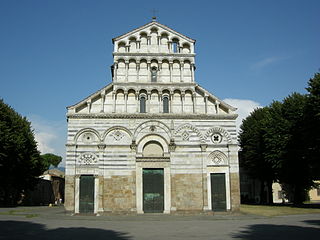
Pisa is a city and comune in Tuscany, central Italy, straddling the Arno just before it empties into the Ligurian Sea. It is the capital city of the Province of Pisa. Although Pisa is known worldwide for its leaning tower, the city contains more than twenty other historic churches, several medieval palaces, and bridges across the Arno. Much of the city's architecture was financed from its history as one of the Italian maritime republics.
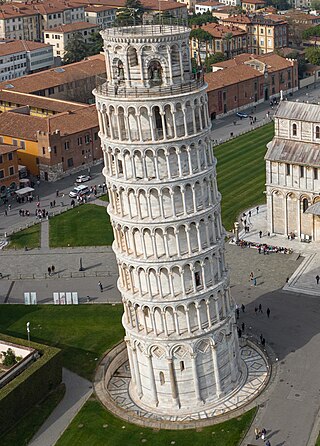
The Leaning Tower of Pisa, or simply, the Tower of Pisa, is the campanile, or freestanding bell tower, of Pisa Cathedral. It is known for its nearly four-degree lean, the result of an unstable foundation. The tower is one of three structures in the Pisa's Cathedral Square, which includes the cathedral and Pisa Baptistry.
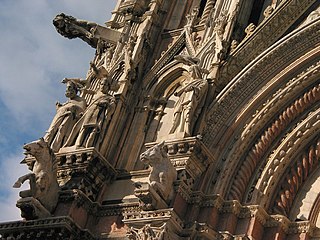
Giovanni Pisano was an Italian sculptor, painter and architect, who worked in the cities of Pisa, Siena and Pistoia. He is best known for his sculpture which shows the influence of both the French Gothic and the Ancient Roman art. Henry Moore, referring to his statues for the facade of Siena Cathedral, called him "the first modern sculptor".

The Piazza dei Miracoli, formally known as Piazza del Duomo, is a walled 8.87-hectare (21.9-acre) area located in Pisa, Tuscany, Italy, recognized as an important center of European medieval art and one of the finest architectural complexes in the world. Considered sacred by the Catholic Church, its owner, the square is dominated by four great religious edifices: the Pisa Cathedral, the Pisa Baptistery, the Campanile, and the Camposanto Monumentale. Partly paved and partly grassed, the Piazza dei Miracoli is also the site of the Ospedale Nuovo di Santo Spirito, which houses the Sinopias Museum and the Cathedral Museum.
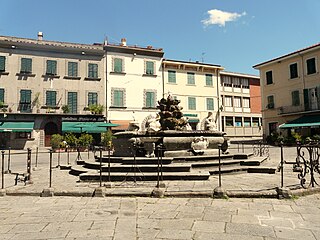
Fivizzano is a comune in the province of Massa and Carrara, Tuscany, central Italy.

Sansepolcro, formerly Borgo Santo Sepolcro, is a town and comune founded in the 11th century, located in the Italian Province of Arezzo in the eastern part of the region of Tuscany.

Pisa Cathedral is a medieval Roman Catholic cathedral dedicated to the Assumption of the Virgin Mary, in the Piazza dei Miracoli in Pisa, Italy, the oldest of the three structures in the plaza followed by the Pisa Baptistry and the Campanile known as the Leaning Tower of Pisa. The cathedral is a notable example of Romanesque architecture, in particular the style known as Pisan Romanesque. Consecrated in 1118, it is the seat of the Archbishop of Pisa. Construction began in 1063 and was completed in 1092. Additional enlargements and a new facade were built in the 12th century and the roof was replaced after damage from a fire in 1595.

Sant'Onofrio al Gianicolo is a titular church in Trastevere, Rome. It is the official church of the papal order of knighthood Order of the Holy Sepulchre. A side chapel is dedicated to the Order and a former grand master, Nicola Canali is entombed there. It is located on the Janiculum. Since 1946, the church has been under the care of the American congregation of the Franciscan Friars of the Atonement.

Barison II or Barisone II was the giudice of the Judicate of Logudoro from 1153 to 1186. He was the son and successor of Gonario II, who abdicated the throne and retired to the monastery of Clairvaux to live out his days.

San Nicola is a church in Pisa, Tuscany, Italy.

Santa Maria delle Grazie Maggiore a Caponapoli or Santa Maria delle Grazie Maggiore is a church located in the historic center of Naples, Italy.
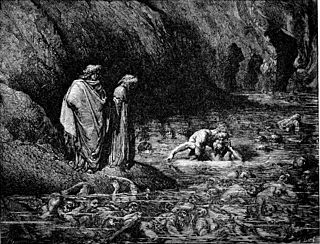
Ruggieri degli Ubaldini was an Italian archbishop.
Poggi del Sasso is a village in Tuscany, central Italy, administratively a frazione of the comune of Cinigiano, province of Grosseto. At the time of the 2001 census its population amounted to 88.
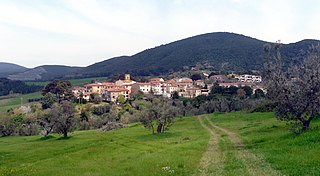
Pomaia is a village in Tuscany, central Italy, administratively a frazione of the comune of Santa Luce, in the Province of Pisa. At the time of the 2001 census its population amounted to 188.
San Torpé is a Roman Catholic church located in Largo del Parlascio #20 in the town of Pisa, region of Tuscany, Italy.

Ubaldesca Taccini was an Italian Catholic nun and member of the Order of Saint John. Her feast day is celebrated on 28 May.
The following is a timeline of the history of the city of Pisa in the Tuscany region of Italy.

Villamagna is a village in Tuscany, central Italy, administratively a frazione of the comune of Volterra, province of Pisa. At the time of the 2001 census its population was 220.
Giovanni dei Conti di Poli, sometimes shortened to Giovanni Conti or anglicized John of Conti, was an Italian nobleman and Dominican friar who served successively as the archbishop of Pisa (1299–1312) and archbishop of Nicosia (1312–1332).










